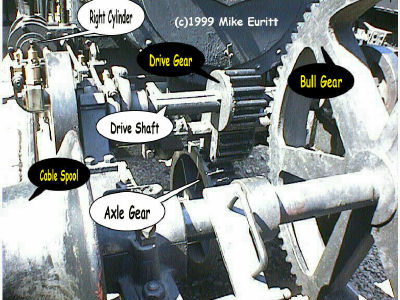Bear Harbor Lumber Co. #1 |
Geared Steam Locomotive Works ©
Photo taken at Railfair 99 in Sacramento, California
by Cheryl Marshall of San Rafael, CA.
Provided courtesy of
Mike Euritt.
Photo Copyrights owned jointly by Cheryl Marshall
&
Mike Euritt - 1999
Bear Harbor Lumber Co. #1
"Gypsy" Locomotives - A General Overview
The Bear Harbor Lumber Company #1 locomotive, pictured, belonged to a group of locomotives nick named "gypsy". As far as it is known by this author, the "gypsy" type locomotives were predominately built by a small number of firms located in California. Similarly, as best can be determined, they were also operated only in California. (Information to the contrary is solicited.)
The "gypsy" locomotives were flexible dual purpose machines. They were logging locomotives and they were "yarding" engines. As a logging locomotive, they operated the same as any other logging locomotive. As "yarding" engines, they would use an attached spool and cable to drag ("yard") logs from the forest floor to a loading point near the track. In most logging operations, this function was usually handled by a dedicated steam engine referred to as a "donkey". The "gypsy" locomotive eliminated the need and expense of this 2nd engine along with the usual crew of men it took to operate it.
One style of "gypsy" locomotive was of the standard "rod" type locomotive, utilizing two forward mounted horizontal cylinders and a side rod for locomotion. A third cylinder, independent of the other two, was dedicated to powering the yarding mechanism. This mechanism consisted of a set of gears that turned one or two cable spools for "yarding" logs.
Another style of "gypsy" was a geared drive locomotive, utilizing
a set of gears with only two center mounted horizontal cylinders for the purpose of locomotion and
"yarding" logs. This is the style that will be further discussed
here-in.
The cylinder rods were connected to a drive shaft that was mounted horizontally in front of and perpendicular to the boiler. On the drive shaft was mounted a drive gear. To enable the locomotive to operate "as a locomotive", this drive gear and the gear on the front wheel axle were manually engaged (with much effort) utilizing intermediate or secondary gearing. For yarding, the large "bull" gear was moved laterally along its shaft to engage it directly with the drive gear. (This movement also took a considerable amount of manual effort.) Once engaged and with the cylinders working, the drive gear spun the "bull" gear which in turn rotated one or more cable spools connected to one or both ends of the "bull" gear shaft. One end of a cable, or "wire rope" as it was called in those days, was attached to a log and the other end was attached to the spool. As the spool rotated, the cable wound around it, dragging the log along the ground from where it lay to a loading point near the track.

Click here for photo without text balloons
This page changed
March 26, 2019 11:28:06 PM